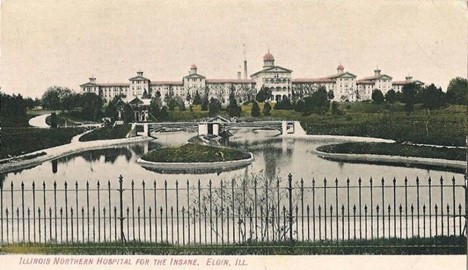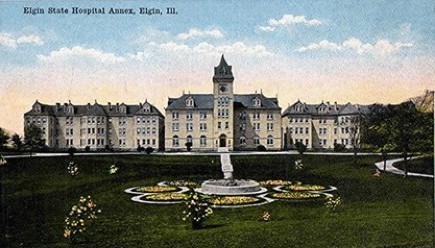by Ron Becker, Class of 2019
John Blair was born in Scotland in 1821. It was there he learned his trade as gardener, landscape architect, and stone mason. Ever a nomad, he emigrated to Canada in 1851. By 1854 he was landscaping the estate of John Holland in Rockford, Illinois. When Mary Manny acquired the estate, he continued working for her. Later, after she married Robert Tinker, he would return to Rockford on a visit and construct a waterfall in the conservatory of Tinker Cottage that Mary and Robert were building.
While in Rockford, Blair submitted horticultural exhibits to the 1863 Sanitary Fair that was held in Chicago. These were so well received that he was asked to design the horticultural hall for Chicago’s 1865 Sanitary Fair. Sanitary Fairs were the fund-raising events of the United States Sanitary Commission (USSC). The USSC was a civilian organization formed to provide medical and sanitary support for the Union Army. Established by an executive order from President Abraham Lincoln, its first General Secretary was Frederick Law Olmstead.
The 1865 Northwestern Sanitary Fair was held in what was then Dearborn Park on Chicago’s lakefront. It was held between May 30 and June 24, 1865. It was the largest such fair up to that time. Perhaps it helped establish Chicago as a location for large national events. To work on the fair, Blair moved to the Chicago area. He bought a home and established his nursery in Oak Park.


Blair became a Superintendent of Parks in Chicago. A Chicago Tribune article on September 25, 1869, reported that employees of several Chicago parks had presented a gold watch to John Blair the previous evening. The inscription on the watch read: “Presented to Mr. John Blair, our Superintendent, as a token of esteem by the employees of Lincoln, Jefferson, Union, and Ellis Parks, September 24, 1869.” He is credited with doing some of the foundational work for Humbolt, Douglas, and Garfield Parks. The full extent of his contribution and work for the West Park Commission may not be fully known because all the records were lost in the Great Chicago Fire. This also ended his employment with the city. Blair was also one of the founding members of the Chicago Horticultural Society.
In Oak Park, Blair laid out the grounds for one of Oak Park’s most prominent men, Henry Austin, Sr. When Frank Lloyd Wright moved to Oak Park, his first dwelling was opposite the Austin estate. In his Autobiography, he relates how he originally thought the grounds were the result of natural development and was surprised to learn they were designed by John Blair. When Blair went to Colorado with Austin, Wright and his mother bought Blair’s house and nursery. Anna Wright moved into the house which today is called Anna’s House, while Frank designed his home and later his studio nestled among the nursery plantings.
Wright is reported to have remarked, “In regard to Oak Park, a certain profusion of greenery characterized the village. I remember well that I came to Oak Park to live for no other reason than that, and the remarkable character of the foliage on the old Blair lot.” The ginkgo tree planted by Blair in the 1860s is still standing and gives its name to the bookstore.



Blair had established a landscaping practice in the Chicago area. In addition to the Austin estate, a remnant of which remains as Austin Gardens, he had a major commission in designing the grounds for the Elgin State Mental Health Hospital. Below are postcard views of the Elgin State Mental Hospital
When Blair accompanied Austin to Colorado he met General William Palmer. He assisted Palmer in urban planning, particularly in laying out the parks in Colorado Springs and nearby Manitou Springs. He built a bridge in the Garden of the Gods and helped landscape Palmer’s mountain lair, Glen Eyrie.
Blair’s final move was back to Canada, in British Columbia. His last major commission was the design of Beacon Hill Park in Victoria, British Columbia. Blair died in 1906 and is buried in Duncan, British Columbia.
John Blair’s style is characterized by a blend of native plantings and ornamental horticulture. Blair’s designs utilized rocks, trees, water, and rustic structural features to create naturalistic landscapes. As a master stone mason, he erected several bridges in his projects. It has been speculated that his works might have influenced Jens Jensen.
The final words on Blair are from his obituary: “Those who knew him are the better for having known him…He has left the imprint of his genius on many places in the new world, and even those who never knew him are benefited by his work.”

CLICK HERE for more stories on The Bridge.















Fascinating. Thanks, Ron.
Thank you, Ron. I had never heard of this guy and it is interesting to see/read how he was “before his times” so to speak, influencing Wright and Jensen (perhaps) who are so well known as the gurus of Prairie landscaping.
Thank you for the in-depth information about John Blair. I give tours of the Frank Lloyd Wright Home & Studio in Oak Park, and the tour always ends by the huge Gingo tree. (Some tour takers can identify the tree—but most can’t.) I mention that FLW bought the lot on which the tree was part of the existing plantings from John Blair, a well-known horticulturist, and the historic Blair home to the east of the tree on Chicago Avenue was purchased by his mother. (The newly wed Frank and Catherine lived with Anna Wright until their home was completed.) When the FLW home was built, it was built around an existing Weeping Willow tree, and when the home was acquired for restoration, wood branches were placed in the wall of the house to show where that tree had been. The plantings on the lot were truly unique.
Thanks for your in-depth article about John Blair. I give tours at the Frank Lloyd Wright Home and Studio, and the tours always end at the huge Gingo tree. (Some tour takers know what kind of tree it is, but most don’t.) Frank Lloyd Wright and his young bride lived with his mother in the John Blair home until their home was completed. Also, Wright had his home built around a large Weeping Willow tree, which Blair had planted. When the home was acquired for restoration, wood branches were put in the wall where that tree had been. It must have been a very unique lot.